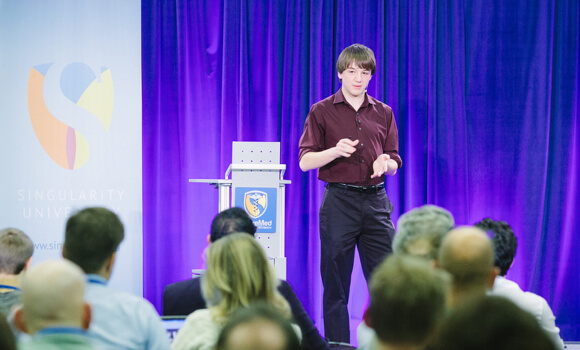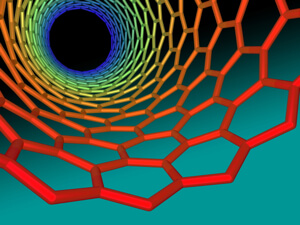INTERVIEW: 16-YEAR-OLD JACK ANDRAKA INVENTS CHEAP, ACCURATE CANCER TEST
Jack Andraka is 16 years old, a sophomore in high school, and a pretty endearing chap. Andraka’s alter ego? Mad scientist. Last year, Andraka developed a very cheap, accurate diagnostic test for pancreatic cancer using antibodies, carbon nanotubes—and research from Google. Andraka’s work went on to win the Intel International Science and Engineering Fair, and at FutureMed 2013, his rapid-fire fifteen minute talk earned a standing ovation. Singularity Hub chatted with Andraka right after his presentation:
Andraka didn’t set out to solve an intractable problem in oncology. But he’s a very bright young man with a curious intellect. And when his uncle and an acquaintance both died of pancreatic cancer—he couldn’t stop wondering why it was such a quick, nearly unstoppable killer.
The answer, as it turns out, is pretty simple: The harder a cancer is to diagnose early, the harder it is to combat after diagnosis. The pancreas lies deep in the abdomen between the stomach and spine. Because of its location, there are no telltale lumps a physical exam would discover and physical symptoms do not present themselves initially.
Worse, pancreatic cancer tends to rapidly spread to neighboring organs like the liver, gallbladder, and small intestine. By the time patients complain of upper abdominal pain, yellow eyes and skin, and weight loss, the cancer is quite advanced and less likely to respond to treatment. The five-year survival rate for pancreatic cancer is a dismal 5.5%.
One day sitting in his high school biology class, Andraka was reading an illicit article on carbon nanotubes used as biosensors (quite the rebel) and listening to a lecture on antibodies with half an ear. As the legend goes, that’s when a mote of inspiration hit him squarely in the neocortex—perhaps the two could be combined to detect molecular-sized cancer clues?
After a good bit of Google-powered research, Andraka sent proposals to 200 professors suggesting the use of carbon nanotubes to test for a biomarker of pancreatic cancer called mesothelin. He received 199 rejections, but one Johns Hopkins professor, Dr. Anirban Maitra, was intrigued. Andraka went on to develop his paper test for pancreatic cancer at Dr. Maitra’s lab.
Andraka’s technique laces single walled carbon nanotubes with mesothelin-specific antibodies and deposits them on a strip of paper. The nanotubes make the paper electrically conductive. He then exposes the paper to a blood sample, and when mesothelin in the blood binds with the antibodies to form larger molecules, it changes the paper strip’s electrical potential.
Measuring this change in electric potential yields an accurate estimate of the mesothelin concentration present in the sample.
Andraka says his test is “168 times faster, 26,000 times less expensive, and over 400 times more sensitive than the current standard.” It costs $0.03 per test and takes five minutes. The test could also potentially be used to diagnose ovarian and lung cancer, both of which also produce abnormal levels of mesothelin.
Andraka’s method and the story behind it have been getting a lot of attention. 60 Minutes attended FutureMed to film his talk and interview him—they were actually filming us as we recorded our short interview. (No pressure!) The Smithsonian Magazine, BBC, Forbes, and Wall Street Journal have all covered his work.
And it’s small wonder. Andraka’s story is extraordinary. His technique is exemplary of a larger movement afoot—from late diagnosis of disease by physical symptoms to early diagnosis at the molecular level. Biomarker tests like Andraka’s could have a huge positive impact on research, treatment, and survival rates in the coming years.
Further, information that was once restricted to a tiny subset of the population is now abundantly available online. Today, more minds than ever have access to more information than ever—an explosive combination that may bring breakthroughs like Andraka’s at an ever-quickening pace in the future.
Image Credit: Deborah Huber Photography; Geoff Hutchison, Flickr


No comments:
Post a Comment